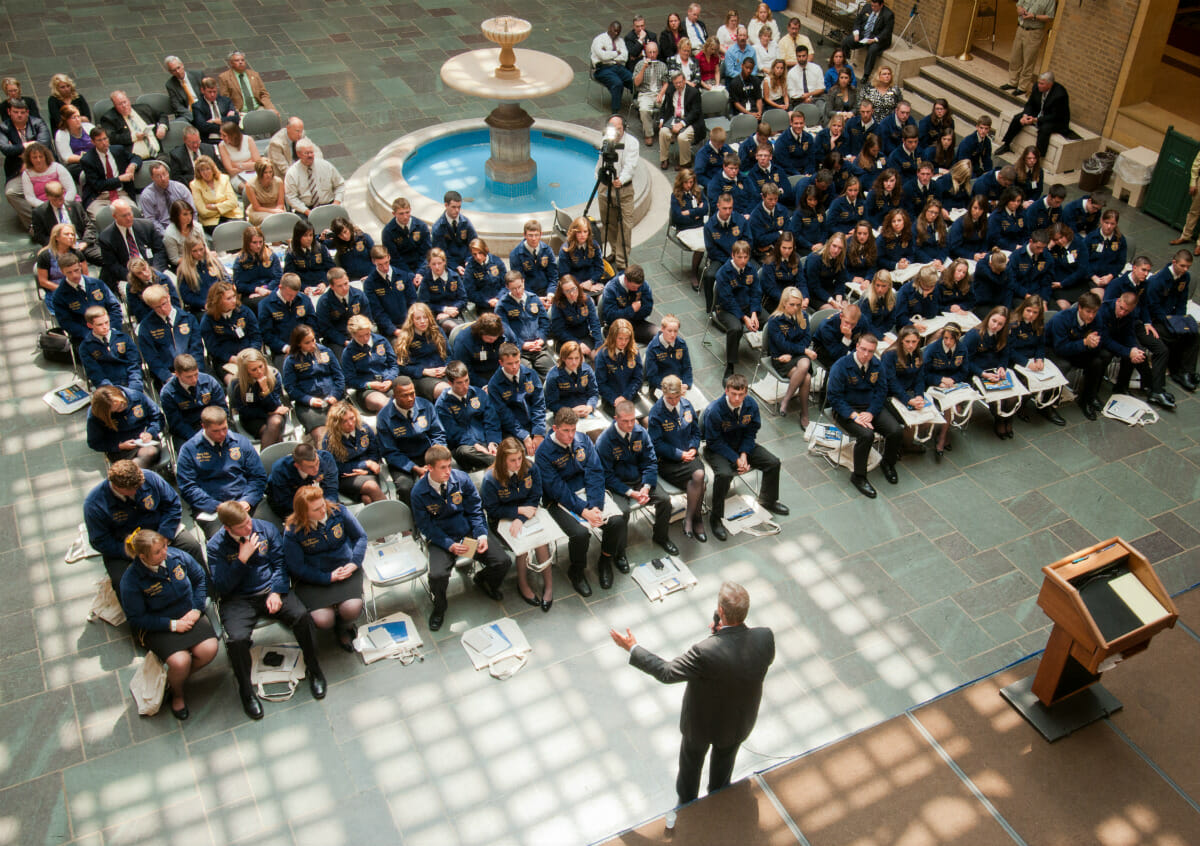Future Farmers of America: Still Relevant?
Like barn dances and the Farmer's Almanac, the FFA (Future Farmers of America) is an old-timey tradition that still exists in the age of lab-grown meat and robot milkers. With a un...
Future Farmers of America: Still Relevant?
Like barn dances and the Farmer's Almanac, the FFA (Future Farmers of America) is an old-timey tradition that still exists in the age of lab-grown meat and robot milkers. With a un...

Like barn dances and the Farmer’s Almanac, the FFA (Future Farmers of America) is an old-timey tradition that still exists in the age of lab-grown meat and robot milkers. With a uniform that dates back to 1933 — modeled here by Napoleon Dynamite — and an earnest, boosterish love of all things farming, the group seems part of a bygone era.
That’s why it may surprise you that the FFA has higher enrollment than ever before, well over half a million members and growing.
This at a time when much ink is spilled about the aging farm demographic. For every farmer and rancher under the age of 25, there are five who are 75+, a worrisome trend. Yet the FFA’s enduring popularity seems to refute these stats — 560,000 young students still like farming enough to voluntarily wear a monogrammed jacket and tie (or a scarf for the ladies).
To gain a little insight, we caught up with college junior Kalie Hall, chosen from thousands of her peers to be this year’s national FFA Secretary. She’s a dyed-in-the-wool Southern farm girl, raised amongst hogs and soybeans in Carnesville, Georgia. But Hall didn’t earn her role on street creds alone — she’s a charming and unflappable spokesman, staying on-message through the saltiest of reporter questions (e.g., “Why are all the FFA officers white?”)

Modern Farmer: What does it mean to be an FFA officer?
Kalie Hall: Hmmm. Well there’s a long selection process, with a barrage of tests and essays and interviews. It wasn’t easy! After they choose six officers, we all take a year off from school to perform our duties.
MF: What duties?
KH: We travel the country, visiting schools, going to conferences, touring agriculture companies, meeting politicians. It’s very exciting — I got to spend some time talking with [Education] Secretary Duncan and [Agriculture] Secretary Vilsack.
MF: Does it sometimes feel like you’re a politician?
KH: I guess so! We’re definitely in the public eye a lot, meeting people and advocating for agriculture.
MF: You meet lots of aspiring young farmers. What is the biggest concern you hear?
KH: They worry about a lack of connection between the general public and farming. It used to be most everybody had someone in their family who was a farmer, or you knew a farmer who lived nearby. These days most people are very removed from agriculture. We’re still figuring out how to bridge that gap.
MF: What are potential solutions?
KH: Social media is one of the best tools we have to connect farmers with non-farmers. It lets producers show pictures of their crops on Facebook, or they can tweet from their tractors. People are interested in how their food is being grown; social media makes it very easy to learn. We can also show the fun side of farming. Have you seen the Peterson Brothers YouTube video, “I’m Farming and I Grow It?”
MF: Yes.
KH: That’s a good one! I just love it.
MF: Do most of your members end up becoming farmers?
KH: Not necessarily. We’ve now identified 300 different agriculture-related career opportunities outside of being a traditional farmer. There are all sorts of jobs, in biotech, animal health, commodities trading, genetics. We talk a lot with leaders of industry who are worried about where their talent will come from.
MF: Farming these days can be quite politically charged. Does the FFA take a stance on say, using pesticides or growing GMO crops?
KH: We try to expose young people to many different ways of farming, and to give them the critical thinking skills to decide how they want to farm. There is no right or wrong way to be a farmer.
MF: A diplomatic answer. What are your thoughts on urban agriculture?
KH: That’s actually one of the most exciting changes we’ve seen. We have chapters in Chicago, Philadelphia, New York — most of the biggest cities have FFA groups now.
MF: We noticed there doesn’t seem to be a lot of diversity in this year’s FFA officers. How does that reflect your membership?
KH: Diversity and inclusion is a very important part of the FFA mission. (Ed. Note: In 1965 the FFA merged with the NFA, an African American farming organization. In 1969, it opened membership to women.) Our membership is 73 percent white, 15 percent Hispanic, 7 percent African American, and 5 percent Native American, Asian and Pacific Islander. Also, 43 percent of our members are girls, and girls hold half of our leadership positions.
We definitely want a diverse membership, in every sense of the word. I’ve met a lot of young farmers, with a range of accents, food preferences, beliefs and everything else. One thing that unites everybody is an inborn fondness for agriculture, an emotional connection to the land.
Photo at top: Secretary of Agriculture Tom Vilsack addresses FFA members, courtesy of the USDA
Follow us

This work is licensed under a Creative Commons Attribution-NoDerivatives 4.0 International License.
Want to republish a Modern Farmer story?
We are happy for Modern Farmer stories to be shared, and encourage you to republish our articles for your audience. When doing so, we ask that you follow these guidelines:
Please credit us and our writers
For the author byline, please use “Author Name, Modern Farmer.” At the top of our stories, if on the web, please include this text and link: “This story was originally published by Modern Farmer.”
Please make sure to include a link back to either our home page or the article URL.
At the bottom of the story, please include the following text:
“Modern Farmer is a nonprofit initiative dedicated to raising awareness and catalyzing action at the intersection of food, agriculture, and society. Read more at <link>Modern Farmer</link>.”
Use our widget
We’d like to be able to track our stories, so we ask that if you republish our content, you do so using our widget (located on the left hand side of the article). The HTML code has a built-in tracker that tells us the data and domain where the story was published, as well as view counts.
Check the image requirements
It’s your responsibility to confirm you're licensed to republish images in our articles. Some images, such as those from commercial providers, don't allow their images to be republished without permission or payment. Copyright terms are generally listed in the image caption and attribution. You are welcome to omit our images or substitute with your own. Charts and interactive graphics follow the same rules.
Don’t change too much. Or, ask us first.
Articles must be republished in their entirety. It’s okay to change references to time (“today” to “yesterday”) or location (“Iowa City, IA” to “here”). But please keep everything else the same.
If you feel strongly that a more material edit needs to be made, get in touch with us at [email protected]. We’re happy to discuss it with the original author, but we must have prior approval for changes before publication.
Special cases
Extracts. You may run the first few lines or paragraphs of the article and then say: “Read the full article at Modern Farmer” with a link back to the original article.
Quotes. You may quote authors provided you include a link back to the article URL.
Translations. These require writer approval. To inquire about translation of a Modern Farmer article, contact us at [email protected]
Signed consent / copyright release forms. These are not required, provided you are following these guidelines.
Print. Articles can be republished in print under these same rules, with the exception that you do not need to include the links.
Tag us
When sharing the story on social media, please tag us using the following: - Twitter (@ModFarm) - Facebook (@ModernFarmerMedia) - Instagram (@modfarm)
Use our content respectfully
Modern Farmer is a nonprofit and as such we share our content for free and in good faith in order to reach new audiences. Respectfully,
No selling ads against our stories. It’s okay to put our stories on pages with ads.
Don’t republish our material wholesale, or automatically; you need to select stories to be republished individually.
You have no rights to sell, license, syndicate, or otherwise represent yourself as the authorized owner of our material to any third parties. This means that you cannot actively publish or submit our work for syndication to third party platforms or apps like Apple News or Google News. We understand that publishers cannot fully control when certain third parties automatically summarize or crawl content from publishers’ own sites.
Keep in touch
We want to hear from you if you love Modern Farmer content, have a collaboration idea, or anything else to share. As a nonprofit outlet, we work in service of our community and are always open to comments, feedback, and ideas. Contact us at [email protected].by Jesse Hirsch, Modern Farmer
August 26, 2013
Modern Farmer Weekly
Solutions Hub
Innovations, ideas and inspiration. Actionable solutions for a resilient food system.
ExploreExplore other topics
Share With Us
We want to hear from Modern Farmer readers who have thoughtful commentary, actionable solutions, or helpful ideas to share.
SubmitNecessary cookies are absolutely essential for the website to function properly. This category only includes cookies that ensures basic functionalities and security features of the website. These cookies do not store any personal information.
Any cookies that may not be particularly necessary for the website to function and are used specifically to collect user personal data via analytics, ads, other embedded contents are termed as non-necessary cookies.